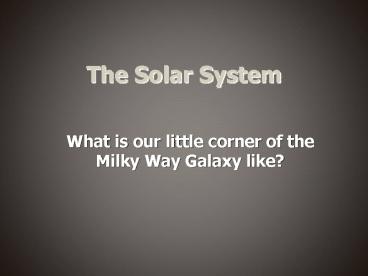The Solar System - PowerPoint PPT Presentation
1 / 18
Title:
The Solar System
Description:
Title: The Solar System Author: Information Technology Last modified by: Mike Wach Created Date: 12/2/1999 4:00:32 PM Document presentation format – PowerPoint PPT presentation
Number of Views:79
Avg rating:3.0/5.0
Title: The Solar System
1
The Solar System
- What is our little corner of the Milky Way Galaxy
like?
2
Composition of the Solar System
- The sun 99.85 of all the matter in the solar
system. - Jupiter contains more than twice the matter of
all the other planets combined. - Star/Sun 1
- Planets 8
- Dwarf Planets 5
3
Size Comparisons
4
Solar System Structure
- All planets orbit the sun in a counter-clockwise
fashion. Orbits are contained within a very
narrow disk or plane. - Most orbits are very nearly circular with the
exception of Mercury and Pluto.
5
Solar System Structure
- The spin axes of most planets and moons are
perpendicular to the orbital plane (Venus and
Uranus are notable counter examples). - Thus, solar system is basically disk shaped with
the Sun near the center.
6
Small Rocky Worlds
- Terrestrial/Rocky Planets Small, dense, rocky
worlds with less atmosphere than the other type
of planet. Craters, no rings, very few moons. - Mercury
- Venus
- Earth
- Mars
7
Jovian/Gaseous Planets
- Jovian Planets Large, gaseous, low density
worlds. Thick gaseous mostly hydrogen
atmospheres, rings, lots of moons, and very large
in comparison to terrestrial planets. - Jupiter
- Saturn
- Neptune
- Uranus
8
Pluto
- Pluto Does not fit the current definition of a
planet. - Pluto is a small icy world clearly different from
either the Jovian and Terrestrial worlds. - Since its discovery by Clyde Tombaugh in 1930, it
has been a unique mystery mostly because of its
great distance from the Earth and is peculiar
orbit.
9
Plutos Orbit
10
Space Debris
- Asteroids ? (minor planets) are small rocky
worlds. Most (not all) orbit between Mars and
JupiterAsteroid Belt . Most are irregular in
shape, crated, and dense.
11
Comets
- An impressive glowing object that is illuminated
by the Sun as it sweeps through the inner solar
system. Dirty snowball theory. (Water and CO2
ices)
12
- Meteor ? falling shooting star bits of rock
and metal falling into the Earths atmosphere and
bursting into vibrant light as they drastically
heat because of the friction created between them
and the Earths atmosphere. These bits are, on
average, tiny specks of dust, sand grain size,
small pebbles NOT large. - Meteoroid ? in space before its fiery collision
with the Earths atmosphere. - Meteorite ? fallen piece that survived the fall.
Most shooting stars are less than 1 gram of
material.
13
Age of the Solar System
- Oldest rocks dated on Earth 3.9 billion years
however, the Earths own volcanism and
plate-tectonics erase most of the evidence!! - Lunar rocks are dated to 4.48 billion years.
- Meteorites 4.6 billion years
- Sun estimated age is based on all the
circumstantial evidence 4.5 - 5 billion years.
It has about a 10 billion-year life.
14
Solar Nebula Theory
A large massive slowly rotating cloud of
interstellar material begins to collapse under
the influence of gravity. A star forming nebula
begins to grow warm and grow denser.
The warming center is becoming a protostar of
mostly hot hydrogen gas. Further out in the
nebula other clumps of dust and debris are
gathering into asteroid sized objects and
planetesimals.
15
Solar Nebula Theory
When nuclear fusion begins we have a new star!
The star will vaporize the inner regions of the
cloud and begin to drive off the gaseous and
dusty material
As the star continues to shine and produce energy
the nebula is driven off revealing the surviving
material planets, comets, and asteroids.
16
(No Transcript)
17
(No Transcript)
18
(No Transcript)































